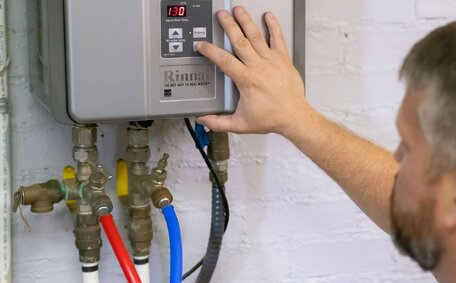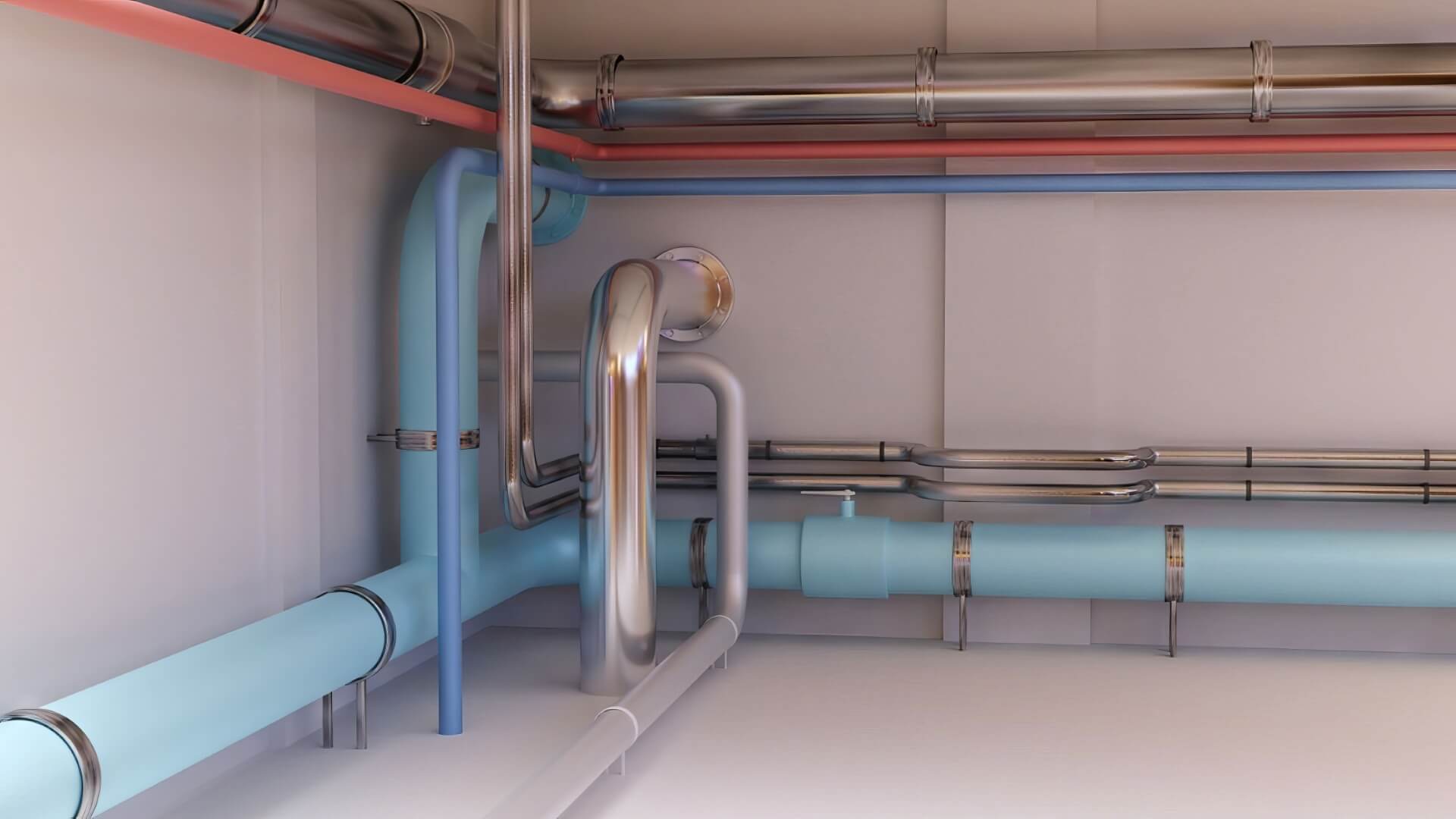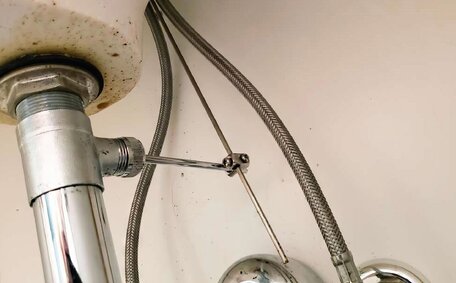Understanding Why Pipes Freeze
Understanding that pipes may burst when temperatures fall below freezing is essential for prevention. Water expands into ice at these temperatures, exerting pressure that may cause a pipe to burst if not properly managed.
Pipes are most susceptible to freezing in unheated spaces such as basements, attics, and garages, as well as in overlooked areas like under kitchen and bathroom cabinets during severe cold spells.
Pipes running against the exterior walls of your home with scant insulation are also prime candidates for freezing.
Understanding why pipes freeze and how ice expansion obstructs them is vital for protecting your home’s plumbing. It’s vital to be proactive by consistently monitoring your plumbing and ensuring water flow to prevent freezing. Awareness of the causes is key to safely thawing pipes and minimising damage should freezing occur.
Identifying Areas at Risk for Frozen Pipes
Areas most vulnerable to freezing pipes are those in uninsulated or draughty parts of your home. This includes:
- Unheated spaces such as attics, basements, garage doors left ajar, and crawl spaces
- Pipes running against exterior walls or ceilings with little insulation
- Kitchen and bathroom cabinet interiors against exterior walls
Inspect pipes regularly and take steps to protect susceptible areas in your home during cold spells, such as using thermal imaging to identify cold spots.
Keep in mind that sudden temperature drops, especially during cold snaps, can quickly freeze pipes before measures are taken.
Preventing Frozen Pipes
Here are essential steps to prevent pipes from freezing during the winter:
- Insulate pipes near cold air or external walls with foam sleeves or fibreglass wraps to shield your plumbing from freezing temperatures.
- Seal any leaks or gaps allowing cold air into your home, particularly near frozen pipes. Use caulk or weather stripping to plug holes and secure your pipe water flow.
- Ensure indoor temperatures stay above 13°C to keep water in the pipes and protect your home’s walls, even when you’re not there. Use programmable thermostats to maintain safe temperatures.
- Turn faucet on slightly to allow a drip during extreme cold. Understanding how to maintain a consistent water flow within pipes hinders freezing.
- For outside spigots, ensure interior valves are closed and keep exterior doors open to prevent cold from concentrating in one area. Then, turn off the taps and cover the exterior faucets with insulating caps or foam covers for protection.
These proactive measures offer strong protection against burst pipes and potential home water damage. Taking small actions now can prevent significant headaches and costs if a burst occurs.
Regularly check your insulation and educate yourself on the signs of pipe freezing and indoor/outdoor temperature management during winter.
Insulating Vulnerable Pipes
Properly insulating areas your pipes traverse is crucial for preventing freezing issues. Ideal materials to use include:
- Pipe insulation foam tubes - Slip over exposed pipes for protection from cold surfaces.
- Fibreglass insulation wraps - Wrap pipes in unheated areas like attics or basements.
- Heat tape - Electrically heated tape to wrap pipes to maintain above freezing temps.
Insulation provides a reliable barrier that lowers the risk of your pipes freezing during cold spells, offering robust protection against freezing conditions. Make sure the insulation is comprehensive, with no gaps that could allow cold air ingress.
Prioritise insulation for any pipes in unheated areas, as well as those running alongside exterior walls and going outdoors. Well-insulated pipes have the highest risk reduction against freezing, safeguarding you from the disasters of burst pipes and ensuing water damage.
For extra protection, combine insulation with other preventative measures like maintaining adequate indoor heating, sealing air leaks, and dripping faucets. Employing a multi-faceted approach gives pipes the best chance to withstand winter without damage.
Maintaining Heat
Maintaining your heating at adequate levels is crucial for preventing frozen pipes. During colder weather, adhere to these important steps:
- Keep your thermostat at a minimum of 13°C for continuous warmth and to prevent pipes from freezing.
- Open cabinet doors to facilitate warm air circulation around pipe sections against exterior walls.
- Use a heat lamp or space heater to deliver extra warmth to uninsulated pipes and maintain a comfortable temperature indoors.
- During intense cold, allowing taps to drip overnight helps prevent water inside pipes from freezing.
Monitoring for frozen pipes is crucial to prevent damage and regulated home temperatures protect your plumbing. Allowing indoor warmth to drop too low leaves them vulnerable when outdoor conditions plunge below freezing.
Combining heat maintenance with sealing leaks, insulation, and paying attention to forecasts for cold snaps gives your plumbing the best shot at making it through winter unscathed.
Letting Faucets Drizzle
Allowing indoor and outdoor faucets to drip slowly during extreme cold helps alleviate pressure and prevents freezing. Turning on the faucet slightly allows water to circulate, which eases pressure build-up from frozen water expansion and ensures continued flow.
To use this method, turn on each cold water tap enough so drops emerge at a slow pace - around 1 drip per second. Ensure you know when to turn both hot and cold water taps to a drip. Ensure you shut off interior valves for hose bibs and outdoor taps first, while keeping exterior faucets open to allow a drip.
The steady movement of water within the plumbing system prevents stagnation and reduces the odds of pipes freezing up. A slow drip from a faucet, as part of an array of prevention steps such as maintaining heat and insulation, can fortify your home against the freezing cold.
What To Do If Pipes Start To Freeze
If you suspect your pipes are beginning to freeze, here’s how you should promptly attempt to thaw them:
- Locate the frozen area. Check where water pipes enter from unheated areas like basements or garages. Feel along pipes for sections that are very cold to the touch.
- Turn the faucet nearby to let warm water trickle out and assist thawing and relieving pressure on the section pipe that’s frozen. This will assist in starting to thaw your frozen pipes.
- To efficiently thaw a pipe, consider the method to apply heat using a heating pad or warm towels, and position space heaters on the impacted section. You should avoid the use of an open flame in these situations.
- Keep applying heat until full running water pressure returns, and you can monitor your pipes to ensure refreezing doesn’t occur.
- Should you find the task challenging, it’s time to call plumber to provide professional assistance.
- Once pipe is thawed, take preventative measures like insulating vulnerable areas.
Employing slow, steady heat to thaw plumbing pipes sections reduces the risk of pipes bursting. Work systematically from the source of cold towards the inside. Refreezing can still occur so insulation and drip faucets are key post-thaw until temperature conditions improve.
Detecting Frozen Pipes
There are a few key signs that indicate your pipes may be frozen:
- No water comes out of faucets, or flow is greatly reduced to a trickle
- Pipes feel much colder to the touch than other water pipes
- Unusual banging or loud cracking sounds coming from the pipes
- Icicles forming on indoor pipes
- Frost buildup on the exterior of pipes
Carefully inspect pipes in unheated areas first if you detect signs of pipes frozen. Check your whole system by trying multiple faucets. Freezes often occur where pipes are exposed near outer walls, attics, or foundations.
Catching early warning signs allows you to quickly intervene before a complete blockage and burst occurs. So stay vigilant in monitoring your plumbing during winter cold snaps.
Thawing Frozen Pipes
There are a few safe methods to thaw frozen pipes:
- Use a hairdryer to direct heat along the entire length pipe, beginning nearest to the faucet. Progress gently towards the colder section of the pipe, applying heat until the normal water pressure is restored. Never leave operating blow dryers unattended.
- Apply warm towels or cloths wrapped around the frozen sections. Soak them in hot water and wring out excess moisture before applying.
- Position portable space heaters to direct warmth on frozen areas. Infrared heaters work best. Monitor pipes until completely thawed.
- Open a hot water faucet closest to the frozen section to relieve pressure and allow thawed water to escape.
- Consider an electric heating tape/cable when other methods fail. Wrap along the frozen area and plug in to generate safe heat.
If you’re at a loss and can’t thaw the pipes, call a licensed plumber straight away for help before serious bursting and water damage takes a toll on your house.
Never use open flames or very high heat in attempts to thaw pipes. This practice can damage your pipes and increase the risk of fires. Employ warm, steady heat patiently, avoiding practices that might cause pipe damage, until full water flow is restored.
Handling Burst Pipes
If a pipe bursts, immediate action is crucial to stop further water damage:
- Identify and turn off your water’s flow at the main shut-off valve. Knowing the location of your main valve, usually near the water meter or where the main water line enters your home, is vital.
- For home safety, switch off electricity coming to your affected areas at the circuit breaker if water comes into contact with outlets, appliances, or wiring.
- Promptly call a licensed plumber to handle the pipe repairs.
- Divert water if feasible by placing buckets, towels, and absorbents under leaks to collect water until repairs are done.
- Quickly move valuables and belongings out of water-affected areas. Take photos/video of all damage for insurance claims.
Burst pipes rapidly inundate homes; hence, it’s crucial to shut off water swiftly as part of an urgent response. Getting the water supply shut-off promptly and calling in professional repairs minimises overall damage. Check with your insurance company, as most home policies cover sudden water damage like burst pipes, but be sure to document everything for your claim.
Preventing Recurring Frozen Pipes
To prevent recurring frozen pipe issues, there are several effective long-term strategies you can implement on your pipes yourself:
- Upgrade insulation around vulnerable pipes using pipe foam wraps or heat tape. Ensure full coverage with no gaps.
- Seal any drafts and leaks to prevent cold air from reaching pipes, particularly in settings at risk of exposure to unheated areas.
- Install freeze prevention gadgets like temperature monitoring systems that automatically open taps to help warm up the internal pipe environment when approaching freezing conditions.
- Consider re-routing problematic pipes through heated rather than unheated spaces.
- Inspect your plumbing before winter to identify weak spots, worn insulation, leaks etc. and make repairs.
- Learn how to fully drain/winterize infrequently used summer water lines.
- Maintain vigilance in monitoring forecasts for extreme temperature drops.
Avoiding recurrent frozen pipe headaches requires being proactive before the cold hits. Regular professional inspections and upgrades to insulation, draft-proofing, and freeze prevention systems ensure dependable protection year after year.
Combining reinforced insulation, sealing off cold air intrusion points, installing automated temperature regulation devices, and being ready to respond quickly at the first sign of issues stops problems before they start. Invest today in your home’s frozen pipe prevention for winters of reliable, trouble-free plumbing ahead.
Improving Insulation
- Wrap pipes with insulation foam tubes or fibreglass sleeves, ensuring complete coverage without gaps for cold air.
- For exposed pipes, enclose them in an insulated pipe box. This fully contains pipes to protect them.
- Use heat trace cables (heat tape) beneath pipe insulation to maintain a minimum temperature.
- Seal insulation ends and joints with weatherproof tape to prevent moisture intrusion.
- Insulate valves, fittings and elbows which are common areas for heat loss.
Upgraded insulation effectively halts the entry of cold air into pipes, providing them with robust protection. It also retains heat from inside your home to keep pipes safely above freezing. Pairing enhanced insulation with other preventive strategies offers the strongest defense against freezing incidents.
If your home older in design, seek a professional’s advice about insulation enhancements and alternative ways to reroute pipes. They can identify the optimal insulation solutions to custom fit your home’s needs.
Sealing Leaks
Finding and sealing air leaks is crucial for preventing cold drafts that can lead to frozen pipes. Carefully inspect areas where pipes enter your home from unheated spaces like basements, crawlspaces and attics. Also check exterior walls near plumbing for gaps.
Use caulk or spray foam sealant to plug the following common trouble spots:
- Gaps around pipes, valves, vents as they pass through walls/ceilings
- Cracks in foundation walls or openings for utilities
- Spaces around exhaust fans, dryer vents, etc
- Loose insulation allowing air intrusion
- Dropped ceilings where cold air can enter
Sealing these leaks helps stop cold drafts from reaching your pipes. Combined with adequate insulation and maintaining indoor heat, it gives your plumbing an effective defence against freezing and burst disasters.






